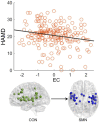Distinct resting-state effective connectivity of large-scale networks in first-episode and recurrent major depression disorder: evidence from the REST-meta-MDD consortium
- PMID: 38148946
- PMCID: PMC10750394
- DOI: 10.3389/fnins.2023.1308551
Distinct resting-state effective connectivity of large-scale networks in first-episode and recurrent major depression disorder: evidence from the REST-meta-MDD consortium
Abstract
Introduction: Previous studies have shown disrupted effective connectivity in the large-scale brain networks of individuals with major depressive disorder (MDD). However, it is unclear whether these changes differ between first-episode drug-naive MDD (FEDN-MDD) and recurrent MDD (R-MDD).
Methods: This study utilized resting-state fMRI data from 17 sites in the Chinese REST-meta-MDD project, consisting of 839 patients with MDD and 788 normal controls (NCs). All data was preprocessed using a standardized protocol. Then, we performed a granger causality analysis to calculate the effectivity connectivity (EC) within and between brain networks for each participant, and compared the differences between the groups.
Results: Our findings revealed that R-MDD exhibited increased EC in the fronto-parietal network (FPN) and decreased EC in the cerebellum network, while FEDN-MDD demonstrated increased EC from the sensorimotor network (SMN) to the FPN compared with the NCs. Importantly, the two MDD subgroups displayed significant differences in EC within the FPN and between the SMN and visual network. Moreover, the EC from the cingulo-opercular network to the SMN showed a significant negative correlation with the Hamilton Rating Scale for Depression (HAMD) score in the FEDN-MDD group.
Conclusion: These findings suggest that first-episode and recurrent MDD have distinct effects on the effective connectivity in large-scale brain networks, which could be potential neural mechanisms underlying their different clinical manifestations.
Keywords: brain networks; effective connectivity; first-episode and recurrent; major depressive disorder; resting-state fMRI.
Copyright © 2023 Zhu, Huang, Li, Yang, Zhao, Yang, Lin, the DIRECT Consortium and Li.
Conflict of interest statement
The authors declare that the research was conducted in the absence of any commercial or financial relationships that could be construed as a potential conflict of interest.
Figures




References
-
- American Psychiatric Association . (2013). Diagnostic and statistical manual of mental disorders: DSM-5 (American psychiatric association Washington, DC: ).
-
- Balasubramanian M., Mulkern R. V., Neil J. J., Maier S. E., Polimeni J. R. (2021). Probing in vivo cortical myeloarchitecture in humans via line-scan diffusion acquisitions at 7 T with 250–500 micron radial resolution. Magn. Reson. Med. 85, 390–403. doi: 10.1002/mrm.28419, PMID: - DOI - PMC - PubMed
-
- Biesheuvel-Leliefeld K. E. M., Kersten S., van der Horst H. E., van Schaik A., Bockting C. L. H., Bosmans J. E., et al. . (2012). Cost-effectiveness of nurse-led self-help for recurrent depression in the primary care setting: design of a pragmatic randomised controlled trial. BMC Psychiatry 12, 1–9. doi: 10.1186/1471-244X-12-59 - DOI - PMC - PubMed
-
- Brzezicka A. (2013). Integrative deficits in depression and in negative mood states as a result of fronto-parietal network dysfunctions. Acta Neurobiol. Exp. 73, 313–325. PMID: - PubMed
LinkOut - more resources
Full Text Sources

